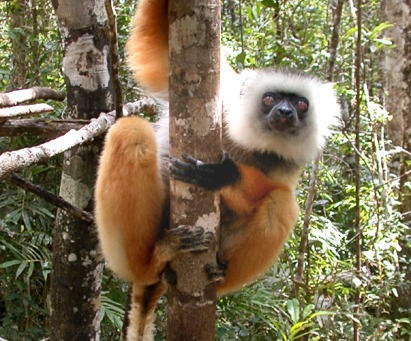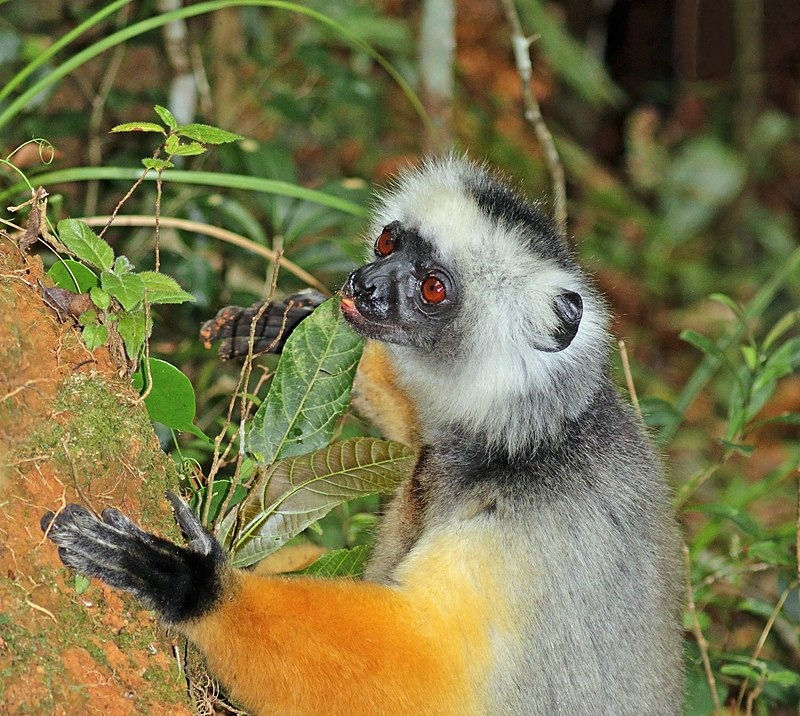PRIMATES OF
SOUTHERN
AFRICA
A primate is any mammal of the group that includes lemurs, lorises, tarsiers, monkeys, apes, and humans. The order Primates, with its 300 or more species, is the third most diverse order of mammals, after rodents and bats. Images, links and information to the following animal cards are provided for by www.wikipedia.org and through our own images and descriptions.
GREATER GALAGO
@Southern Africa



#thick-tailed bushbabies , The species are found in coastal regions of East Africa ranging from the Juba River in Somalia, through Mozambique and Tanzania down to the northern parts of South Africa and as far west as Angola. For the most part they live in woods but also in wooded grasslands and even city parks.
CHACMA BABOON
@Southern Africa




#Papio ursinus , Also known as the Cape baboon, is, like all other baboons, from the Old World monkey family. It is one of the largest of all monkeys. Located primarily in southern Africa, the chacma baboon has a wide variety of social behaviours, including a dominance hierarchy, collective foraging, adoption of young by females, and friendship pairings.
SYKES MONKEY
@Southern Africa




#Cercopithecus albogularis , also known as the white-throated monkey or Samango monkey, is an Old World monkey found between Ethiopia and South Africa, including south and east Democratic Republic of Congo. It has a large white patch on the throat and upper chest, and a grizzled (not blackish) cap.
FAT-TAILED DWARF LEMUR
@Madagascar




#Cheirogaleus medius , The fat-tailed dwarf lemur, also known as the lesser dwarf lemur, western fat-tailed dwarf lemur, or spiny forest dwarf lemur, is endemic to Madagascar.
PYGMY MOUSE LEMUR
@Madagascar


#Microcebus myoxinus , Also known as Peters' mouse lemur or dormouse lemur, is a primate weighing only 43–55 g (1.5–1.9 oz); it is the second smallest of the mouse lemurs. Its dorsal side is a rufous-brown colour, and creamy-white ventrally. It lives in dry deciduous forests.
AYE-AYE
@Madagascar



#Daubentonia madagascariensis , A long-fingered lemur with rodent-like teeth that perpetually grow and a special thin middle finger. It is the world's largest nocturnal primate. It is characterized by its unusual method of finding food: it taps on trees to find grubs, then gnaws holes in the wood using its forward-slanting incisors to create a small hole into which it inserts its narrow middle finger to pull the grubs out.
INDRI
@Madagascar




#Indri indri , Also called the babakoto, is one of the largest living lemurs, with a head-and-body length of about 64–72 cm (25–28+1⁄2 in) and a weight of between 6 and 9.5 kg (13 and 21 lb). It has a black and white coat and maintains an upright posture when climbing or clinging. It is monogamous and lives in small family groups, moving through the canopy, and is herbivorous, feeding mainly on leaves but also seeds, fruits, and flowers.
COQUEREL'S GIANT MOUSE LEMUR
@Madagascar


#Mirza coquereli , Coquerel's giant mouse lemur, also known as Coquerel's dwarf lemur or the southern giant mouse lemur, is a small nocturnal lemur endemic to Madagascar. This species can be found in parts of the Madagascar dry deciduous forests.
CROWNED LEMUR
@Madagascar




#Eulemur coronatus , The crowned lemur is endemic to the dry deciduous forests of the northern tip of Madagascar. It eats a diet of mostly flowers, fruits, and leaves. The population is estimated to 1000–10,000 individuals as of 2004, most of which live within the Ankarana Plateau although there is also a population on the Montagne d'Ambre.
BLACK LEMUR
@Madagascar


#Eulemur macaco , a species of lemur from the family Lemuridae. Like all lemurs, it is endemic to Madagascar. Originally, the species was thought to have two subspecies, Eulemur macaco macaco and Eulemur macaco flavifrons, both of which were elevated to species status by Mittermeier et al. in 2008 to Eulemur macaco and Eulemur flavifrons respectively.
RED LEMUR
@Madagascar


#Eulemur rufus , Also known as the rufous brown lemur or northern red-fronted lemur, is a species of lemur from Madagascar. Until 2001, the species E. rufus was considered a subspecies of the common brown lemur, E. fulvus, after which it was classified as its own species. In December 2008, the species was split into two separate species, the red lemur, E. rufus, distributed in dry lowland forests in northwestern Madagascar.
RING-TAILED LEMUR
@Madagascar



#Lemur catta , A large strepsirrhine primate and the most recognized lemur due to its long, black and white ringed tail. It belongs to Lemuridae, one of five lemur families, and is the only member of the Lemur genus. Like all lemurs it is endemic to the island of Madagascar.
MILNE-EDWARDS SIFAKA
@Madagascar


#Propithecus edwardsi , Milne-Edwards's sifaka , or Milne-Edwards's simpona, is a large arboreal, diurnal lemur endemic to the eastern coastal rainforest of Madagascar. Milne-Edwards's sifaka is characterized by a black body with a light-colored "saddle" on the lower part of its back. It is closely related to the diademed sifaka, and was until recently considered a subspecies of it. Like all sifakas, it is a primate in the family Indriidae.
MOHOL BUSHBABY
@Southern Africa


#Galago moholi , The Mohol bushbaby is a medium size species with a head-and-body length of 15 cm (6 in) and a tail of 23 cm (9 in).The head is broad, with a short muzzle, orange eyes and diamond-shaped black eye-rings. The nose-stripe is whitish and the ears are large and grey. The dorsal surface of the body has a greyish-brown pelage, and the underparts are white, sometimes with a yellowish tinge.
VERVET MONKEY
@Southern/Eastern Africa




#Chlorocebus pygerythrus , The vervet monkey simply vervet, is an Old World monkey of the family Cercopithecidae native to Africa. The term "vervet" is also used to refer to all the members of the genus Chlorocebus. The five distinct subspecies can be found mostly throughout Southern Africa, as well as some of the eastern countries
YELLOW BABOON
@Central/Southern Africa




#Papio cynocephalus , The species epithet means "dog-head" in Greek, due to the dog-like shape of the muzzle and head. Yellow baboons have slim bodies with long arms and legs, and yellowish-brown hair. They resemble the Chacma baboon, but are somewhat smaller and with a less elongated muzzle. Their hairless faces are black, framed with white sideburns.
GRAY MOUSE LEMUR
@Madagascar



#Microcebus murinus , The gray mouse lemur, grey mouse lemur or lesser mouse lemur, is a small lemur, a type of strepsirrhine primate, found only on the island of Madagascar. The species is named for its mouse-like size and coloration and is known locally (in Malagasy) as tsidy, koitsiky, titilivaha, pondiky, and vakiandry.
PALE FORK-MARKED LEMUR
@Madagascar


#Phaner pallescens , The pale fork-marked lemur, or western fork-marked lemur, is known from western Madagascar; south of the Fiherenana River to the region of Soalala. It is listed on CITES Appendix I.
EASTERN WOOLLY LEMUR
@Madagascar



#Avahi laniger , Also known as the eastern avahi or Gmelin's woolly lemur, is a species of woolly lemur native to eastern Madagascar, where it lives in the wet tropical rainforest at low elevations along the eastern coast of the island or they can also inhabit the northern tip of the island with other species.[4] The woolly lemur name refers to their thick, tightly-curled hair, whereas their generic name avahi refers to their high-pitched defensive call.
COQUEREL'S SIFAKA
@Madagascar



#Propithecus coquereli , A diurnal, medium-sized lemur of the sifaka genus Propithecus. It is native to northwest Madagascar. Coquerel's sifaka was once considered to be a subspecies of Verreaux's sifaka, but was eventually granted full species level, and is listed as endangered due to habitat loss and hunting. In popular culture, it is known for being the species of the title character in the children's TV show Zoboomafoo.
DIADEMED SIFAKA
@Madagascar



#Propithecus diadema , The diademed sifaka, or diademed simpona, is an endangered species of sifaka, one of the lemurs endemic to certain rainforests in eastern Madagascar. Along with the indri, this species is one of the two largest living lemurs, with an average weight of 6.5 kg[4] and a total adult length of approximately 105 centimetres (41 inches),[5] half of which is its tail.
BLUE-EYED BLACK LEMUR
@Madagascar


#Eulemur flavifrons , Also known as the Sclater's lemur, is a species of true lemur. It can attain a body length of 39–45 cm, a tail length of 51–65 cm- a total length of 90–100 cm, and a weight of 1.8-1.9 kg. Being a primate, it has strong hands with palms like a human, which have a rubbery texture to give it a firm grip on branches. Its tail is longer than its body and is non-prehensile
RED-BELLIED LEMUR
@Madagascar




#Eulemur rubriventer , a medium-sized strepsirrhine primate with a luxuriant chestnut brown coat. This lemur is endemic to eastern Madagascan rainforests and is distinguished by patches of white skin below the eyes, giving rise to a "teardrop" effect, particularly conspicuous in the male.[
SOUTHERN LESSOR BAMBOO LEMUR
@Madagascar


#Hapalemur meridionalis , The southern lesser bamboo lemur, also known as the southern bamboo lemur, rusty-gray lesser bamboo lemur,[4] and southern gentle lemur, is a species of bamboo lemur endemic to southern Madagascar.
BLACK AND WHITE RUFFLED LEMUR
@Madagascar



#Varecia variegata , An endangered species of ruffed lemur, one of two which are endemic to the island of Madagascar. Despite having a larger range than the red ruffed lemur, it has a much smaller population that is spread out, living in lower population densities and reproductively isolated. It also has less coverage and protection in large national parks than the red ruffed lemur.
MILE EDWARD'S SPORTIVE LEMUR
@Madagascar


#Lepilemur edwardsi , Also known as Milne-Edwards' weasel lemur, is a species of lemur in the family Lepilemuridae. It is endemic to Madagascar. Its natural habitat is subtropical or tropical dry forests. It is threatened by habitat loss.[1]
An enormous problem for these animals is the limited resource of safe sleeping sites. These are essential for their survival since they provide shelter from predators and weather conditions.









.png)
.png)